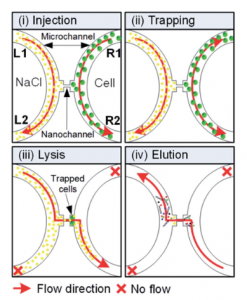In this small review, you will find the relevance of syringe pumps for nanofluidic implementation in microfluidic devices. Key technologies as DNA/RNA extraction and nanoparticle manipulation are presented as an example of the exciting branches that Chemyx syringe pumps offer. We will address some of the most important features than syringe pumps provide for the development of this new techniques, the additional tools as nanopatterning and proper protocol will be part of the discussion.
Real-time Template-Assisted Manipulation of Nanoparticles In a Multilayer Nanofluidic Chip
The study of nanofluidics in microfluidic devices with nano-channels lead to the improvement of classical techniques as the cell lysis and nucleic acid extraction. It is possible to capture single or few cells with the subsequent extraction using nanochannels of 100 nm; highly pure samples are prepared by nanofluidic extraction through nanochannel technologies confirmed by UV spectrometry for lab-on-a-chip devices(Kant et al., 2015).
Nanopatterning Is Crucial For Nanofluidics
Before to start a nanofluidic study is important to fabricate nanochannels, the most used techniques are E-beam lithography and etching. Another technique is the nanoimprint lithography which ca produce nanofluidic channels of even 10 nm width.
Chemyx Syringe Pumps For The Nanofluidic Chip
Microchip allows the cell injection, trapping and lysis simply by using a Fusion-200 3µl/min an extra Fusion-200 pump in the other side of the microfluidic chip provides osmotic pressure with 100 mM NaCl at 5µl/min. The trapped cells were lysed by the flow from the NaCl stream and then eluted using a syringe with buffer(Kant et al., 2015).

Figure 1. From Kant 2015, showing the cell lysis procedure with a micro channels and nanochannels by syringe pumps.
It is possible to use nanochannels for cell material extraction specifically DNA, the technique combines microfluidics for milling through the microchannels. Nano-Drop with UV spectra allows the quantification of the extracted material; the output is DNA and RNA in the proper ratios. The nanochannel device can separate small volumes of samples. Real-time PCR or DNA/RNA hybridization are technologies which can be coupled with this extraction device as sensors. Nanofluidics will optimize the amount of sample needed for lab-on-a-chip technologies.
Nanochannel Flow And Nanopatterning
Controlling nanoparticles placement is a key milestone in the development of nanotechnology. Electrokinetic force allows nanoparticle control in an aqueous environment which derives in nanoparticle arrays. The nanofluidic channel provides manipulation and the concomitant production of a multilayer nano-chip. It is important to control the release of the nanoparticles and dynamically capturing and releasing at the same time. Eventually, this will provide reconfigurable nanostructure patterns for new applications as biosensing, drug delivery on target and nanoplasmonic detection(Chen et al., 2011).
Nanojet N500 Chemyx syringe pumps move the fluorescent bead nanoparticles to achieve this outstanding result. The process produces a multilayer structure manipulated in real time. The electrokinetic force permits nanopatterning and nano-rearrangement. The authors produce 2D nanoparticle array using the 200 nm in a 600 nm periodicity. The new technology will provide new material for plasmonic, sensors and smart surfaces. The control of aqueous media is relevant for applications in the construction of new interfaces for lab-on-a-chip among others.
Concluding remarks
Nanochannels and syringe pumps allow single particle manipulation from fluorescent nanoparticles to DNA/RNA extraction from hold cells. Noteworthy, Chemyx syringe pumps help in the obtainment of these fine tune technologies. They are relevant in lab-on-a-chip and nanopatterning surfaces equally with potential in detection methods. Even when syringe pumps are part of microfluidic devices, the nanochannel tool provides a bridge for further control with inexpensive equipment and most important the development of a new arena for scientists.
References
- Chen, H.M., Pang, L., Gordon, M.S., Fainman, Y., 2011. Real-time template-assisted manipulation of nanoparticles in a multilayer nanofluidic chip. Small 7, 2750–2757. https://doi.org/10.1002/smll.201100264
- Kant, K., Yoo, J., Amos, S., Erkelens, M., Priest, C., Shapter, J.G., Losic, D., 2015. Microbial cell lysis and nucleic acid extraction via nanofluidic channel. RSC Adv. 5, 23886–23891. https://doi.org/10.1039/c5ra01336d
